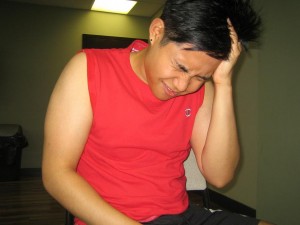A headache is described as any pain in any region of the head and can be described as dull, throbbing or sharp. The pain in the forehead region is considered common. Various types of headaches exist. Depending on the signs and symptoms, the doctor can determine the exact cause of the headache and how to manage it. Most cases of headaches are not caused by serious issues. A doctor should be consulted if the headache is accompanied by symptoms such as nausea, stiff neck or dizziness.
Tension headaches
A tension headache is considered as the most prevalent type of headache. Individuals who experience a tension headache feel as if there is a tight band wrapped around the head. The pain is usually a dull, aching sensation.
The muscles of the scalp, neck and shoulders feel tender. Always bear in mind that a tension headache can last for half an hour up to a week. Even though a tension headache can be difficult to distinguish from migraine headaches, a migraine is usually accompanied by visual symptoms while tension headaches are not.
Causes of tension headaches

Tension headaches are usually caused by tense scalp and neck muscles. This can be triggered by depression, head injury, anxiety or stress. In case the individual holds his/her head in the same position for extended periods of time such as working in a computer, it can cause a tension headache. Other causes of tension headaches include excessive smoking, jaw clenching, eye strain, sinus infection, overextension as well as viral conditions such as flu or common cold.
Cluster and migraine headaches
Migraine headaches are also common and oftentimes accompanied by symptoms such as nausea, vomiting, light sensitivity and appetite loss. The pain is often described as throbbing and typically felt on one side of the head. Some cases are triggered by certain foods such as processed foods, chocolate and MSG. Other potential triggers include bright lights, loud noises, allergic reactions, hormonal changes, changes in sleeping patterns and certain odors.
Cluster headaches are quite common in men than women and usually chronic and recurrent. A cluster headache is usually one-sided and starts abruptly at the neck up to the temple. The pain is often severe and involves teary eyes and a stuffed nose.
Treatment
Tension headaches are often managed with pain medications such as naproxen sodium, ibuprofen or aspirin. Some over-the-counter treatments involve a combination of medications such as acetaminophen, aspirin and caffeine.
There are also over-the-counter medications that should not be used more than 9 days a month or they can trigger rebound headaches that keep recurring. The migraines can be managed with medications such as ergots, triptans or isometheptene. The triptans are also effective in managing cluster headaches as well as oxygen treatment, steroid medications and injections with dihydroergotamine.
